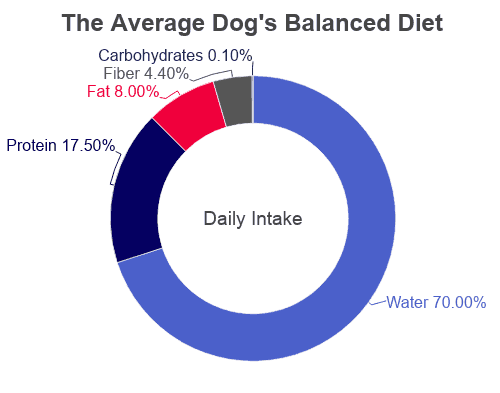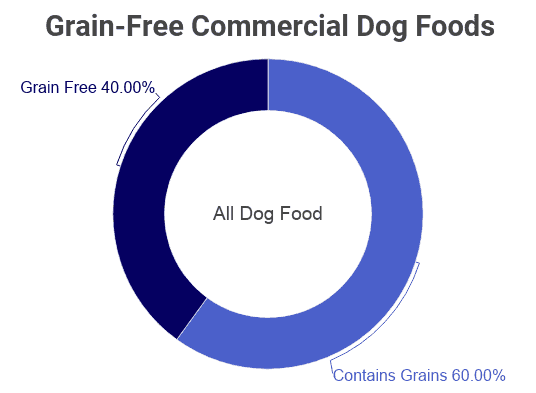In light of popular media claims, our research team analyzed reports from dozens of the nation’s leading authorities on pet health. While grain-free foods may serve to supplement a healthful diet, data suggest a completely grain-free diet may be harmful to most dogs.
Report Highlights. Dogs are indifferent omnivores, meaning their natural diet is meat-based with balanced portions of plant matter. While there are many reasons why a dog may require a low-grain or grain-free diet, most dogs are healthiest when fed a well-balanced diet that includes protein-rich whole grains.
- A protein-rich diet limited in carbohydrates is ideal for most dogs.(1)(2)
- Dog food that is grain-free is not necessarily low in carbohydrates nor gluten-free.(3)
- Grains in commercial dog foods are often “fillers” that offer little nutritional value.(1)
- Some grain-free commercial dog foods also use non-grain fillers that make for an imbalanced diet.(4)
- These same grain-free dog foods appear to be linked to an increased risk of heart disease among dogs.(5)

Grain-Free Dog Food Health Considerations
Veterinarians caution that poor quality or nutritionally unbalanced foods may be labeled “grain-free.” These may contain fillers that are, at best, devoid of nutrients and at worst, toxic. Some alternative fillers appear to correlate with diagnoses of dilated cardiomyopathy (DCM). This has led some veterinarians to condemn grain-free diets and foods they derisively refer to as BEG &ndash: boutique, exotic, and grain-free foods.
- Dogs that get a lot of exercise are more likely to benefit from a grain-free or reduced-grain diet than low-energy dogs.(6)
- Potatoes are not uncommon in grain-free foods, but they don’t provide much nutrition for dogs.(7)
- Dogs do not digest fiber well; some GF brands use high-fiber fillers in place of grain fillers.(8)
- Most dogs thrive on a diet that is 5% fiber.(9)(10)
- In 560 cases of canine DCM reported to the FDA, 93% of the dogs’ diets contained high amounts of legumes, such as lentils and peas, which are high in fiber.(11)
- 90% of these high-fiber pet foods were advertised as “grain-free.”
- 81% of the affected dogs ate diets composed of dry food only.
- 99% of the DCM cases were reported in 2018 and 2019, with the years 2014-2017 averaging just 2 annual cases.
- 17% of cases affected Golden Retrievers.
- 21% of cases were fatal.
| Signs of Food Allergy | |
|---|---|
| 1. Excessive Flatulence | 4. Vomiting or Indigestion |
| 2. Diarrhea or Loose Stool | 5. Frequent Ear Infections |
| 3. Skin Irritation or Rash | 6. Swelling or bloating |
Benefits of Grain-Free Dog Food
For some dogs and dog owners, quality grain-free (GF) foods offer a range of potential advantages. Grain-free dog food lacks filler grains, which offer little dietary value, impede digestion, and build bodily fat. Animal products with some fruit and/or vegetables makes for a nutritious, healthy meal – depending on dogs’ individual needs, such a meal may or may not include whole grains.
- A reduction in grains may improve a dog’s digestion, aiding nutrient absorption and the elimination of waste.(6)
- Dogs that absorb nutrients more efficiently need less food and are less likely to overeat.
- More efficient nutrient absorption and waste elimination also makes dogs produce less fecal waste.
- A grain-free or low-grain diet may help active dogs maintain their body weight.
- GF or low-grain diets may promote protein and fat digestibility in some dogs.
- GF dog food also appears to help improve some canines’ overall bodily condition.
- Some dogs are allergic to grains or develop allergies to the grains in their diet.
- Active dogs on GF diets develop better muscular condition, including strength and energy efficiency.
- Grains are likely to cause excessive flatulence in many breeds.
- Low-grain and grain-free diets may improve a dog’s skin, coat, and breath.
| Dogs’ Nutritional Needs | |
|---|---|
| Water | A dog should consume one ounce of water per pound of their total body weight each day. Wet food contains an average of 70%-75% water and is consistently more nutritious than dry foods. |
| Protein | An adult dog’s diet should be about 10%-14% protein, whereas a growing puppy’s food should contain up to 25% protein to encourage muscle growth. Low-fat animal proteins, such as venison and eggs, improve a dog’s health. |
| Fat | A moderate amount of fat provides essential nutrients, such as amino acids and omegas, and curbs overeating by helping a dog feel “full.” Most dogs love salmon oil, which is a healthy fat that keeps their coat shiny. |
| Vitamins & Minerals | Dogs benefit from vitamins and minerals much as humans do. A healthy diet includes plenty of Vitamins A, B, C, D, E, and K, as well as calcium, magnesium, and phosphorus. Severe vitamin or mineral deficiencies can be very harmful to a dog’s health. |
| Digestive Enzymes | The nutrients in dog food are no good if they’re indigestible. Dogs are not able to digest proteins found in starches, for example. Enzymes aid digestion by helping to break foods down into their useful components, such as iron and potassium. |
| Carbohydrates | While there are no dietary recommendations for dogs regarding carbohydrates, this macronutrient gives dogs the energy they need on a daily basis. Eliminating carbohydrates from a dog’s diet entirely can cause permanent bodily damage. |

Filler Grains in Commercial Dog Foods
Feeding dogs a portion of protein-rich whole grains has been a dietary standard since at least 2,000 B.C.E., when Roman poet Terentius advised that farm dogs should eat a diet of meat, bone, and milk-soaked barley. Grains commonly found in commercial dog foods often serve to supplement more expensive – and more nutritious – ingredients. These are the grains most likely to harm a dog’s health.
- 60% of commercial dog foods contain some amount of grains.(12)
- Dogs cannot digest uncooked starches found in common filler grains.
- Corn is a common filler grain, too much of which likely contributes to canine obesity.
- Meat is 92% digestible for dogs, whereas corn is only 63% digestible; wheat is 52% digestible.
- Commercial dog food manufacturers have always used grains as fillers to “stretch” more expensive ingredients.
- The first commercial dog food product was a biscuit that was mostly wheat meal with some vegetables and cow blood added, setting a precedent for grain- and flour-based pet foods.
- An 80% increase in the rate of disease among pet dogs over 50 years appears to be linked to processed foods.(13)
- Veternarians saw a 37% increase in cases of overweight and obese dogs over five (5) years; in cats, there was a 90% increase.
- According to animal nutritionists, protein should be the first ingredient on a dog food nutrition label.
Benefits of Homemade Grain-Free Foods
The U.S. Food and Drug Administration regulates the quality of pet food. Guidelines for pet food, however, are not as strict as requirements for food meant for human consumption. Many pet owners have taken to making their dog’s food themselves to avoid the risks that come with feeding their animal commercially-prepared foods from dubious sources.
- Homemade food offers a pet owner more control over nutrient proportions.
- Many commercial pet foods contain ingredients declared unfit for human consumption by the FDA.
- In the pet food industry, words like “Premium,” “Natural,” and “Holistic” have no legal definition and are essentially meaningless.
- Meats in commercial foods may contain high amounts of antibiotics and growth hormones.
- Homemade foods can be made in mass quantities and then canned for storage.
- Homemade grain-free dog foods may also incorporate other dietary strategies, such as the inclusion of raw foods.
Sources
- Is Grain-Free Dog Food Safe?
- A Study of the Nutritional Effect of Grains in the Diet of a Dog
- It’s Not Just Grain-Free: An Update on Diet-Associated Dilated Cardiomyopathy
- Effects of Different Carbohydrate Sources on Taurine Status in Healthy Beagle Dogs
- What Dog Owners Need to Know About the FDA’s Grain-Free Diet Alert and DCM
- Grain Free Diets for Utility Dogs During Training Work: Evaluation of the Nutrient Digestibility and Faecal Characteristics
- Nutrients Required by Dogs
- Top Rated Grain Free Food For Dogs
- The Facts You Need Before Feeding Your Dog a Fiber Regiment
- FDA Investigation into Potential Link between Certain Diets and Canine Dilated Cardiomyopathy
- FDA, Questions & Answers: FDA’s Work on Potential Causes of Non-Hereditary DCM in Dogs
- History of Pet Food
- Human Grade: Should Pets Eat the Same Food That We Do?
- Obesity and Other Chronic Conditions on the Rise, Banfield Says
- An Analysis of the Pet Food and Pet Treats Industry
- NRC Nutritional Requirements for Adult Dogs
- Guide to Grain-Free Dog Food
